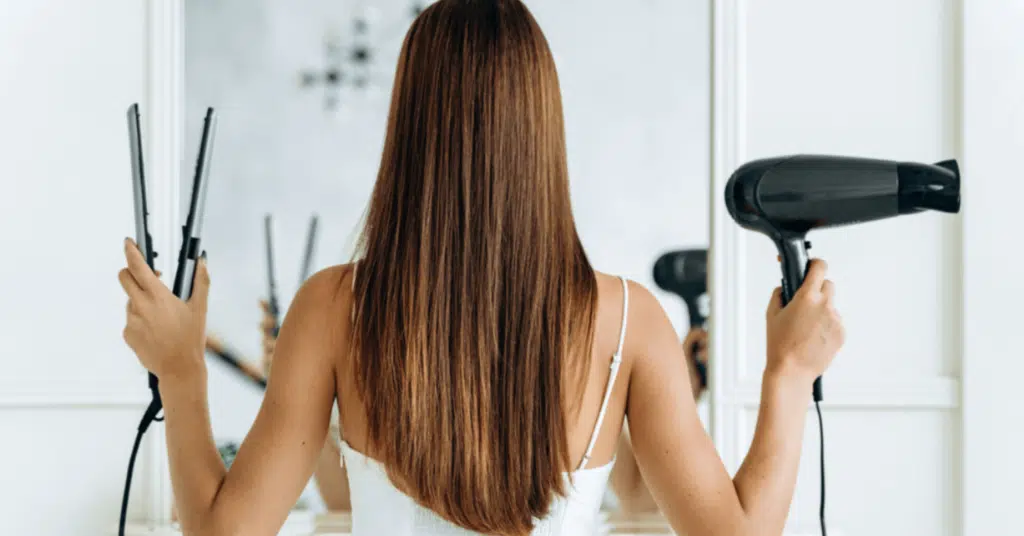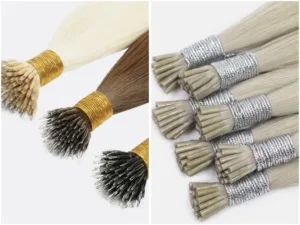Hair extensions can stay smooth and long-lasting, but only when clients understand what actually causes damage. Many issues come from daily habits, not the hair itself. With the right knowledge, you can protect your installs and keep clients happy.
The 10 main things that damage hair extensions are harsh chemicals, improper installation, excessive heat, tight hairstyles, overwashing and wrong hair products, saltwater, chlorine, sunlight, sunscreen, poor brushing, bad sleeping habits, and incorrect storage. These factors weaken the cuticle, cause dryness, tangling, and early breakage.
 If you want to understand why these ten factors matter and how to correct them, keep reading. I will break down each damage source clearly so you can educate clients and safeguard your extension work.
If you want to understand why these ten factors matter and how to correct them, keep reading. I will break down each damage source clearly so you can educate clients and safeguard your extension work.
What are the 10 things that damage hair extensions?
Clients often believe that high-end extensions can withstand anything. But even the best full cuticle hair needs proper protection, because extensions no longer receive natural scalp oils. This makes them more sensitive to friction, heat, and external stress.
The ten key things that damage hair extensions include chemicals, improper installation, heat, tight hairstyles, overwashing, saltwater, chlorine, sunlight, sunscreen, brushing habits, sleeping habits, and storage mistakes.
#1 Harsh Chemicals
Chemical exposure is the **number one** cause of extension damage. Extensions—no matter how high the quality—absorb bleach and color faster than natural hair. This means even light toners or low-volume developer can cause dryness and protein loss.
Common chemical risks:
– Bleach lifting too fast
– Toner left on too long
– Perm solutions touching extensions
– Keratin straightening products
– Alcohol-based removers applied incorrectly
Effects:
Cuticle burns, brittleness, loss of shine, tangling, and mid-shaft breakage.
#2 Improper Installation
Bad install techniques damage both the client’s natural hair and the extensions.
Common installation mistakes include:
– Using too much tension
– Overdirecting rows
– Installing too close to the scalp
– Choosing the wrong weight for the client’s hair
– Poor sectioning that causes matting
Effects:
Slippage, root breakage, shedding, uneven weight distribution, and discomfort.
#3 Excessive Heat
Heat is an invisible killer of hair extensions. Flat irons, curling wands, and blow dryers weaken protein bonds inside the strands.
Examples of heat mistakes:
– Using 220–230°C / 430–450°F
– Flat ironing wet extensions
– Applying heat directly onto tape tabs or keratin bonds
– Using no heat protectant
Effects:
Stiff ends, white dots on strands, dryness, and loss of elasticity. 
#4 Tight Hairstyles
High ponytails, slick buns, and constant tension can weaken both natural hair and extensions.
Risk areas:
– Sides of the head
– Front hairline
– Nape
Effects:
Tension alopecia, loose bonds, snapped strands, and discomfort.
#5 Over-Washing and Hair Products
Extensions do not receive natural scalp oils, so frequent washing removes the little moisture they have. When clients wash too often or use the wrong products, the cuticle dries out and loses its smooth texture. Many commercial shampoos contain sulfates, alcohols, and heavy silicones that either strip moisture or create buildup on the strands.
High-risk situations include:
– Washing extensions more than 2–3 times per week
– Using sulfate shampoos designed for oily scalps
– Applying conditioner directly onto bonds or tapes
– Choosing heavy styling products that coat the cuticle
– Using oils too close to adhesive areas
Effects:
Dryness, tangling, dullness, rapid wear, weakened bonds, buildup, and knots near the ends.
Proper washing frequency and product choice are essential for long-term extension health. Stylists should guide clients toward sulfate-free, lightweight, extension-safe formulas that hydrate without weakening adhesives.
#6 Saltwater & Chlorine
These two environmental triggers destroy extensions faster than most clients realize.
Saltwater:
Pulls moisture out of the hair → causes brittleness.
Chlorine:
Leaves a coating that creates friction and discoloration.
Effects:
Sticky feeling, tangling, green tones in blonde extensions, dryness. 
#7 Sunlight and Sunscreen
UV exposure dehydrates the cuticle. But the real danger is sunscreen.
Chemical SPF turns blonde extensions peach or pink.
This is a known and documented issue in the hair industry.
High-risk situations:
– Sunscreen transferred by hands
– Sunscreen mist landing on hair
– Sitting in direct sun for hours
Effects:
Discoloration, dryness, and dullness.
#8 Brushing Techniques
Incorrect brushing causes shedding, snapping, and loosening of bonds.
Common mistakes:
– Brushing from roots to ends
– Using the wrong brush
– Brushing when wet
– Pulling too aggressively
Effects:
Mid-shaft breakage, shedding, weak bonds. 
#9 Sleeping Habits
Friction at night destroys the cuticle layer.
High-risk sleeping situations:
– Sleeping with loose hair
– Cotton pillowcase
– Wet hair at bedtime
– Long hair rubbing against shoulders
Effects:
Matting at the nape, tangling, dryness.
#10 Storage Mishaps
Clip-ins, halos, and ponytails get damaged when stored incorrectly.
Common mistakes:
– Shoving extensions into drawers
– Leaving them damp
– Storing without brushing
– Folding wefts sharply
Effects:
Creasing, tangling, dehydration, and shedding.
Damage Category Summary
| Cause | Main Risk | Visible Result |
|——-|———–|—————-|
| Chemicals | Cuticle burn | Dryness |
| Bad installation | Tension or slippage | Breakage |
| Heat | Protein loss | Brittleness |
| Tight styles | Pulling | Bond weakness |
| Overwashing | Dehydration | Tangles |
| Salt/chlorine | Moisture loss | Roughness |
| Sun/sunscreen | Chemical reaction | Discoloration |
| Brushing | Pulling | Shedding |
| Sleeping | Friction | Matting |
| Storage | Compression | Tangles |
What are signs of extension damage?
Stylists need to identify early signs of damage to guide clients before the problem gets worse.
Signs of extension damage include dryness, shedding, matting, sticky tape, discoloration, breakage, and weak bonds.
Below are the most important warning signs and what they mean.
1. Rough, Dry Texture
Indicates dehydration, heat damage, or saltwater exposure.
2. Excessive Matting
Usually caused by friction, poor brushing, or sleeping with loose hair.
3. Shedding and Breakage
Signals weakened cuticle layers from harsh brushing or chemicals.
4. Slipping or Loose Bonds
Caused by oils, conditioners on the roots, or incorrect installation.
5. Sticky or Soft Tape Tabs
Heat or oil exposure weakens adhesive.
6. Color Fading or Color Change
Sunscreen and UV light cause discoloration.
7. Split Ends
Result of dryness, overwashing, and excessive heat.
Sign Table
| Sign | Meaning | Cause |
|——|———|——-|
| Dry | Cuticle lifted | Heat |
| Matted | Friction | Sleeping |
| Shedding | Weak strands | Brushing |
| Slipping | Weak bonds | Oils |
| Sticky tabs | Melted adhesive | Heat |
| Discoloration | Chemical reaction | Sunscreen |
| Split ends | Dehydration | Overwashing |

How to get hair extensions silky again?
When extensions feel dry or rough, you can restore silkiness with proper hydration, gentle products, and careful styling practices.
You can make hair extensions silky again by deep conditioning, trimming split ends, lowering heat, adding nourishing oils, and reducing friction.
Restoring smooth texture requires replacing moisture, sealing the cuticle, and protecting the hair from future stress.
Step 1: Hydrating Mask
Use a rich mask once a week. Apply from mids to ends only.
Step 2: Use Sulfate-Free Shampoo
Sulfates strip color and moisture, especially on lighter shades.
Step 3: Leave-In Conditioner
Reduces tangles and friction throughout the day.
Step 4: Apply Lightweight Oils
Argan or jojoba oil seals moisture without heavy buildup.
Step 5: Reduce Heat
Keep tools at medium temperatures. Always use heat protectant.
Step 6: Gentle Brushing
Start from ends and support the root with your hand.
Step 7: Trim Damaged Ends
A small trim can dramatically improve texture.
Step 8: Avoid Daily Washing
Washing too often makes extensions dry fast.
| Action | Benefit |
|——–|———-|
| Hydration mask | Restores softness |
| Leave-in | Reduces friction |
| Natural oils | Seals moisture |
| Heat control | Prevents brittleness |
| Brushing gently | Less breakage |
| Reduced washing | Longer lifespan |
| Trim | Removes dryness |

My opinion
From a manufacturer’s perspective, most damage comes from daily habits, not the hair quality. Full cuticle extensions last long when clients understand how fragile the cuticle is. Education is the strongest tool. When stylists explain these ten damage factors clearly, clients protect their investment and trust your service more.
FAQ
1. Do hair extensions get damaged easily?
Yes, because they no longer receive natural scalp oils.
2. Why do my extensions dry out so fast?
Lack of natural oils and heat exposure cause fast dehydration.
3. Can I use purple shampoo on extensions?
Yes, but sparingly. It can dry out the hair.
4. Why are my blonde extensions turning peach or pink?
This comes from chemical sunscreen reacting with the hair.
5. Will chlorine ruin my extensions?
Yes. Chlorine strips moisture and can discolor blonde extensions.
6. Can I sleep with wet hair extensions?
No. It causes matting, tangling, and bacterial buildup.
**7. How often should I wash extensions?**
Once or twice per week is ideal.
8. Can I curl extensions every day?
You can, but the heat will shorten their lifespan.
9. Why are my tape-ins slipping?
Oil, conditioner, or heat near the tabs can weaken adhesive.
10. Can damaged extensions be repaired?
Mild damage can improve; severe damage may require replacement.
11. Is brushing too often bad?
Brushing is good—but aggressive brushing causes breakage.
12. What pillowcase should clients use?
Silk or satin reduces friction and matting.
13. Can I color extensions darker?
Yes. Light to dark is safe. Dark to light is not recommended.
14. Do extensions need special shampoo?
Yes. Use sulfate-free, extension-safe formulas.
15. Can sun exposure damage extensions?
Yes. UV rays weaken the cuticle and fade color.
16. Why do extensions feel sticky?
Heat or oils near adhesive bonds can melt product.
17. How often should clients move up extensions?
Every 6–10 weeks depending on the method.
18. Do I need to trim extensions?
Yes. A micro trim keeps them smooth.
19. Can I swim with extensions?
Not recommended. If necessary, braid hair and use leave-in conditioner.
20. How long should high-quality extensions last?
Full cuticle extensions can last 1–2 years with proper care.
CONCLUSION
Hair extensions stay healthy when clients avoid chemicals, heat, friction, and poor daily habits. With the right care routine, extensions remain smooth, strong, and long-lasting.




